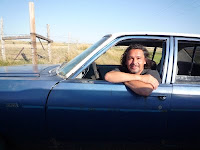 This year’s imagineNATIVE Film + Media Arts Festival ran from October 14-18 with an array of films, workshops, music showcases as well as art exhibitions. These past few days I had a chance to see some of the films in this year’s festival.
This year’s imagineNATIVE Film + Media Arts Festival ran from October 14-18 with an array of films, workshops, music showcases as well as art exhibitions. These past few days I had a chance to see some of the films in this year’s festival.
Reel Injun by Cree filmmaker Neil Diamond (pictured left) opened the festival. The film had its premiere in September at TIFF. Diamond gives us a lesson on the portrayal of North American Natives that is thoughtful and funny. We come to know the “Hollywood Indian,” as such characters were known way back when, through clips from movies from as far as the early 1920’s to today’s films. Diamond also takes us on a road trip from in his “rez” car through many parts of the US. The mix of interviews and archival footage put things in perspective. Like many other minorities, aboriginal people just want to be portrayed realistically. The film’s topic isn’t new but it has some great anecdotes and some tidbits of historical information that may be new to some of you. I’m glad I got a chance to see it since I had missed it at TIFF.
Professor Norman Cornett by award-winning filmmaker Alanis Obomsawin is the story of former McGill professsor of theology, Norman Cornett. Obomsawin gives us a captivating looks at Cornett’s unorthodox teaching style and popularity among students, which may be the reasons why he was terminated from his post after fifteen years. Obomsawin combines interviews with some of Cornett’s former students and colleagues/friends. The students all agreed that he taught them about their sense of self; something not many university professors are willing to explore. Cornett would ask his students to write down thoughts, feelings, reactions to various topics ranging from politics, religion to music and art in general. He called this “dialogical sessions” and indeed they were in dialogue with themselves and each other.
Interesting to see how an institution like McGill decided Cornett’s work was not in line with their ideals, and so on. In Cornett’s view, the classroom should be a community. When he was dismissed, McGill gave no reasons. Cornett decided to go into litigation and is still trying to find out why he lost his job. Obomsawin does a great job in bringing us a close-up of Prof. Cornett, his work, his life outside of work. Funny that in a class where students were actually learning something and not just regurgitating information back, the university feels is not good enough. I found myself wanting to advocate for Prof. Cornett. His words summarize him succinctly , “[I] don’t give in to hate… keep my eyes on the good, the right, the just.”

CBQM: The Biggest Little Radio Station by Dennis Allen. All the way from the Teetl’it Gwich’in community of Fort McPherson in the North West Territories, we get to know the people who run and keep the local radio station alive. The radio station broadcasts a range of shows from daily occurrences in the town, messages from one neighbour to another, bingo night and of course, music shows. I love seeing how many of the town’s senior citizens had their own shows. This is definitely a film about storytelling, celebrating this town’s culture and at the same time sharing it with the audience. I really enjoy hearing other people’s stories and this film, told many; I really enjoyed it.

The closing films included the short film Wave a Red Flag by Adam Garnett Jones. The film was produced for the 2010 Vancouver Olympics. The feature film of the night was Barking Water by Sterlin Harjo. The film revolves Frankie who only has a few days left to live and asks his old love, Irene to drive him “home.” On their road trip, the make several stops to visit with old friends and family. Through their journey, we come to know Frankie and Irene’s stories. he film includes great backdrops in the landscape and colours as we go on this trip with Irene and Frankie. Harjo did a great job, in my opinion, of creating a film that engages you and moves you without it being sappy. It was a nice ending to a festival full of great stories.


